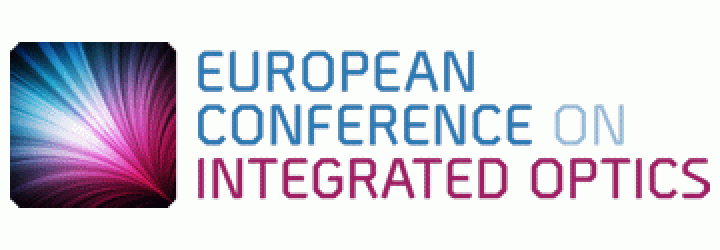High-gain waveguide amplifiers based on potassium rare-earth double tungstates
Yean-Sheng YONG, Sergio A. VÁZQUEZ-CÓRDOVA, Shanmugam ARAVAZHI, Christos GRIVAS, Jennifer L. HEREK, Sonia M. GARCÍA-BLANCO, and Markus POLLNAU
Optical Sciences Group, MESA+ Institute for Nanotechnology, University of Twente, P.O. Box 217, 7500 AE Enschede, Netherlands
Integrated Optical Microsystems Group, MESA+ Institute for Nanotechnology, University of Twente, P.O. Box 217,
7500 AE Enschede, Netherlands
School of Physics and Astronomy, University of Southampton, Southampton SO17 1BJ, UK
Department of Materials and Nano Physics, School of Information and Communication Technology, KTH−Royal Institute of Technology, Electrum 229, Isafjordsgatan 22−24, 16440 Kista, Sweden
y.s.yong@utwente.nl
The down -scaling of the rare-earth-doped amplifier to chip-scale device length is beneficial for signal amplification within short-reach interconnects such as optical backplanes and for the realization of novel active/passive integrated optical chips. Thus far, with the demonstration of 20 dB net gain, high bit-rate operation at 170 Gb/s, and gain bandwidth over 80 nm in the C-band, as well as 14.4 dB net gain at 1064 nm wavelength, rare-earth-doped amorphous Al2O3 is a very promising material for waveguide amplifiers. The corresponding peak gain per unit length of Er3+- and Nd3+-doped Al2O3 are ~2.0 dB/cm and 6.3 dB/cm, respectively. To further increase the gain per unit length, a host material with higher transition cross-sections and higher active-ion solubility is needed. In this work, it is shown that highly Yb3+doped and Er3+-doped monoclinic potassium rare-earth double tungstate, KRE(WO4)2 epitaxial layers match these two conditions and produce higher gain per unit length.
Optically integrated InP-Si3N4 hybrid laser
Youwen FAN, Jörn P. EPPING, Ruud M. OLDENBEUVING, Chris G. H. ROELOFFZEN, Marcel HOEKMAN, Ronald DEKKER, René G. HEIDEMAN, Peter J. M. VAN DER SLOT, and Klaus-J. BOLLER
University of Twente, MESA+ Institute for Nanotechnology, Laser Physics and Nonlinear Optics Group, Enschede 7500 AE, The Netherlands
SatraX B.V., Enschede 7500 AL, The Netherlands 3LioniX B.V., Enschede 7500 AL, The Netherlands 4XiO Photonics B.V., Enschede 7500 BG,
The Netherlands
corresponding author e-mail: y.fan@utwente.nl
Abstract—We present the first demonstration of an optically integrated InP-Si3N4 hybrid laser. The feasibility and viability of facet-to-facet, butt-coupled integration is proven by single-frequency operation, tunability across a wide range of 43 nm (including the entire telecom C-band) with spectral linewidths as narrow as 87 kHz.
Electro-Optic Modulation in Silicon Nitride Photonic Integrated Circuits by means of ALD ZnO Overlays
Artur HERMANS, Michiel VAN DAELE, Jolien DENDOOVEN, Stéphane CLEMMEN, Christophe DETAVERNIER, Roel BAETS
Photonics Research Group, Ghent University – imec, 9052 Ghent, Belgium Center for Nano- and Biophotonics (NB-Photonics),
Ghent University,9052 Ghent, Belgium
Department of Solid State Sciences, Faculty of Sciences, Ghent University, 9000 Ghent, Belgium
artur.hermans@ugent.be
Second-order nonlinear optical (χ(2)) effects are at the basis of many applications such as fast electro-optic modulators (EOMs) and optical parametric oscillators. But most of these χ(2) devices make use of bulk materials or low-contrast waveguides. By integrating χ(2) effects on a chip and exploiting the advancements in nanophotonic circuit design, cheaper, smaller and more efficient χ(2) devices could be realized. The CMOS-compatible Si and SiN platform have proven to be well-suited for photonic integration, however, they lack significant χ(2) nonlinearity. We propose using atomic layer deposited (ALD) zinc oxide to fill this need. ALD lends itself well to photonic integration as it is a low-temperature, conformal deposition technique that provides thickness precision at the monolayer level. ZnO is a wide band gap material (~3.3 eV) that crystallizes preferably in the hexagonal wurtzite structure, point group 6mm. We report on strong second-harmonic generation (SHG) in polycrystalline plasmaenhanced ALD (PE-ALD) ZnO thin films deposited on glass substrates. Furthermore, we have observed the linear electro-optic (EO) effect in SiN waveguides coated with PEALD ZnO. To the best of our knowledge, this is the first demonstration of the linear EO effect in a waveguide with a χ active ALD overlay.
High Optical Quality, Electrically-driven-compatible InP-on-Si Hybrid Interface elaborated at 300°C
Anne Talneau, I. Sagnes and G. Patriarche
CNRS-C2N Centre de Nanosciences et de Nanotechnologies, route de Nozay, F-91460 Marcoussis
Corresponding author: anne.talneau@lpn.cnrs.fr
Abstract: In the domain of Silicon photonic integrated devices, the ability to electrically operate the hybrid III-V on Si or SOI interface constitutes the last integration milestone yet to be achieved. This final milestone will open the full 3D field for completely new design of hybrid devices, and will bring immense gains in terms of thermal-budget improvement, chip power consumption, footprint and the integration of driving electronics to boost data transfer rates. We demonstrate here that Ozone-activated bonding of III-V on Si, operated at 300°C to be CMOS-processing compatible, provides the thinnest -1nm thick- oxideintermediate layer already achieved, and provides a high optical quality of the interface. Such a hybrid interface is very promising for electrical injection through the interface.
Chirp Managed Optical Link based on a Directly Modulated InP/Si DFB Laser
Amin ABBASI, Hongtao CHEN, Jochem VERBIST, Xin YIN, Johan BAUWELINCK, Gunther ROELKENS and Geert MORTHIER
Photonics Research Group, INTEC, Ghent University -imec,
Gent, 9000, Belgium
IDLab, INTEC, Ghent University – imec, Gent, 9000, Belgium amin.abbasi@ugent.be
In order to meet the requirement for applications such as inter-datacenter interconnection and PON systems, a high speed data transmission over at least 20 km of standard single mode fiber is desired. Transmission over such long distances has been done traditionally using externally modulated light sources in the C band, because fiber losses are minimal in this wavelength band and the inherent chirp of directly modulated laser diodes decreases the dispersion tolerance of the link. This limits the transmission link distance for the directly modulated optical signal to about 5 km at 10 Gb/s.
Fabrication of Add-Drop Multiplexers in Fused Silica by Femtosecond Laser Direct Writing
Vítor A. AMORIM, João M. MAIA, D. ALEXANDRE, P. V. S. MARQUES
Center for Applied Photonics, INESC TEC, Rua Dr. Roberto Frias,
Porto, 4200-465, Portugal
Department of Physics and Astronomy, University of Porto,
Rua do Campo Alegre, Porto, 4169-007, Portugal
Department of Physics, University of Trás-os-Montes e Alto Douro,
Quinta de Prados, Vila Real, 5000-801, Portugal
vitor.a.o.a@hotmail.com
Optical add-drop multiplexers (OADMs) can be used in telecommunication networks for wavelength-division multiplexing (WDM). Fig. 1 (a) shows a schematic of a possible OADM configuration, which is based on a Mach-Zehnder interferometer and that has been investigated in this work.

